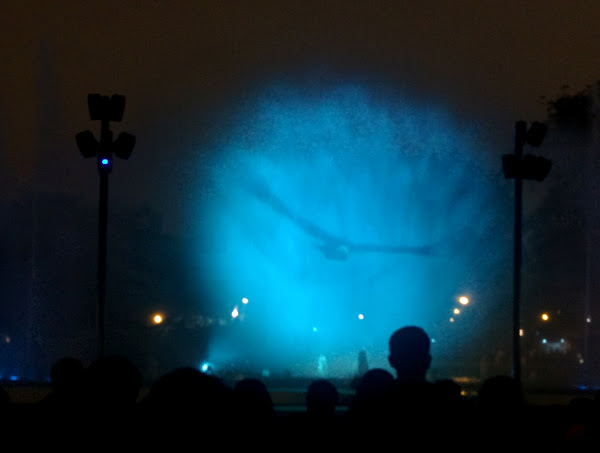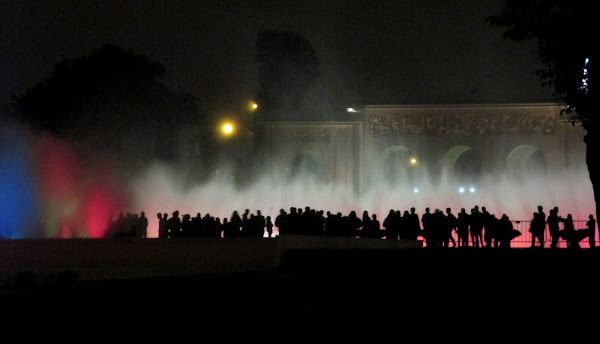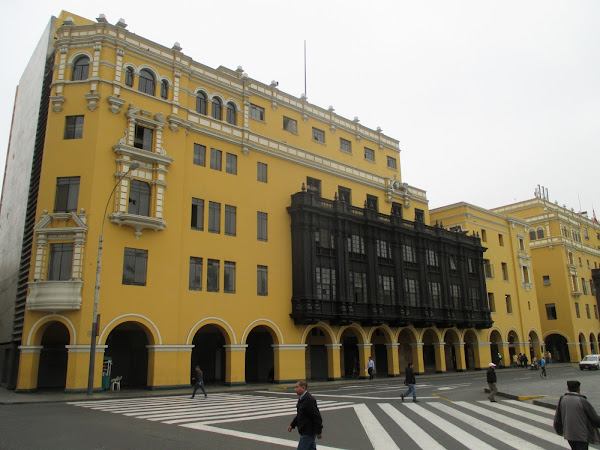Compared to the jungle, Lima felt like an entirely different planet. I've never been so glad to be back in civilization. We had a big suite to ourselves at the Peru Star Hotel in the hip and modern San Isidro neighborhood. It came complete with some nice outdoor seating and a small bar serving food and drinks in the mornings.

The Peru Star courtyard. I felt like I a was on a relaxing vacation here rather than in a fight for survival. Photo credit to Monica for this one.
To complete our journey back into the land of the living we indulged at a nearby pizzeria called Antica. It was refreshing to taste something as familiar as pepperoni and mushroom pizza.
We then ventured out to the Parque de La Reserva, which holds the world record for being the largest water fountain park. It was amazing! Going at night was the right decision. And without even planning it we arrived during a themed event: all the music they played over the light and water shows was from Star Wars. You can't escape the big franchises even in foreign countries. There was also a simultaneous dog show competition, which provided some good laughs and juxtaposition to the epic music around us.

This is the largest and first fountain you see when entering the park.

They projected video in several places, using the water as a screen. Here's an eagle soaring to the Imperial March.

This park was clearly a favorite attraction for the locals. It got pretty crowded in places.

There's an entire novel ready to be written based on this one picture.
Leaving the park we grabbed an Uber - the wait times were a lot longer than I'm used to in the US (consistenly 10-20 minutes), but it saved us a lot of pain from trying to flag down and haggle with taxis. It also saved us money: a thirty minute ride across town was only ever $2-3! This is the second time I'd been able to use my apps in a foreign country, and it makes things ridiculously convenient. This paragraph brought to you by T-Mobile and their free data when out of the country.
Our destination for dinner was Huaca Pullclana. It's an ancient ruin of a pyramid with a fancy restaurant set right in the middle of it. Fine dining next to unearthed walls that were constructed 1800 years ago! Surrounded by history, I sipped on a pisco mojito, a variation on the country's cocktail of choice, the pisco sour. I had a passion fruit martini next, and we chomped down the first of many ceviches. Fried crab claws in soy sauce came next, followed by fried prawns with potato in a sweet green sauce. We rounded things out with vanilla ice cream served atop nut caramel and cooked pineapple.

Our dinner table post-meal, with ancient walls in the background.
Then we went back to the hotel and slept for 13 hours.
When we finally got moving the next day we went to lunch at La Mar Cebicheria. On the way there our driver told us this restaurant was owned and operated by chef Gaston Acurio. It turns out that chefs in Lima are celebrities, and the locals love to talk about them and brag about how well they know them. It was common to hear them referred to on a first name basis: "Oh La Mar? That's one of Gaston's restaurants. I met Gaston once..."
La Mar was my favorite meal of the entire trip - though to be fair, there were a lot of close calls. And that shouldn't be surprising: by one count, Lima boasts 3 of the 50 best restaurants in the world. That's the same number as New York!
I tried some local beers while munching on the local version of chips - sweet potatoes and plantains - in some awesome nutty sauces. The main course was maki with crab and avocado, a seafood platter, and their special, the saltado pacifico, which was a cheese-stuffed ravioli with BBQ scallops and prawns. I was so happy after that meal.

Crowded, noisy, and oh so tasty. I really liked everything about La Mar. That includes the bright pastel colors against the slate interior. And those chairs were surprisingly comfortable.
We walked off the food by spending the rest of the day meandering through the Miraflores neighborhood. We traversed a multitude of city parks, and made a long stop when we found the ocean. The weather in Lima is similar to San Francisco - it's gray and cool. Light jacket temperatures.

A typical city park on the ocean.
The next day we made our visit to the historical center, centered around a plaza simply - and aptly - called the "Main Square" in English. The architecture was very Spanish, all the buildings washed in bright, solid colors.
We went inside the Lima Cathedral, where we were surprised to find hundreds of real human skulls and a few complete skeletons. It's a Christian practice that dates back to the beginning to entomb bones beneath the altar, but most churches in the US are simply too new, being built after the tradition fell out of favor in modern times. It was a fascinating, if macabre, insight into church history.
We ventured next door to the Archbishop Palace, which gave us a glimpse at what luxury looked like 500 years ago. It was filled with paintings and sculptures and religious artifacts. Don't touch anything.
When we came outside again we stumbled into protests blocking the streets. This is the second time I've accidentally joined a protest crowd while traveling abroad. It took us a while to figure out, but in the end we discovered it was a union march.

Bright, solid tones dominated the historic center of Lima.
We did lunch across town at Maido, which is number 13 on that list I mentioned of best restaurants in the world. We paid for the full 16 course experience. Even with tiny bites for most of the courses, it amounted to far too much food. There were a lot of experiments, with flavors as well as presentation. Every dish came with its own distinct plating and silverware. There was even an egg served in a nest on a mini tree at one point. I forced myself to try everything, and the only real mistake was the river snail. I almost didn't keep it down.

This is a river snail. It was the size of my fist. And it was absolutely disgusting.
We went shopping in the Inca Markets after eating. They're a mix of enclosed and open air markets specializing in hand-crafted goods. But we ultimately decided not to buy much until later in the trip so we didn't have to carry it all with us.
Our final day in Lima was largely uneventful; we visited more city parks, chief among them Mariscal Castilla, a water park focused on children. We even spent some time in a Wong, which is a general goods store chain, comparable to a Target or Walmart. I always enjoy seeing how the average day of a local denizen plays out, and going to the Wong definitely provided that perspective.
I loved Lima, and I would easily go back given the chance. And if I did nothing but eat and drink and sleep and explore city parks I'd be content.